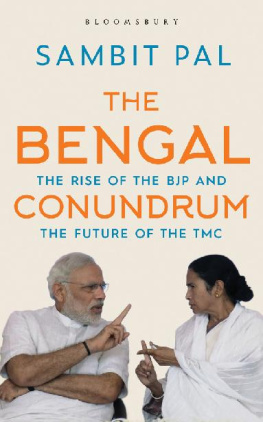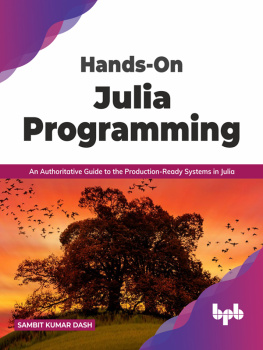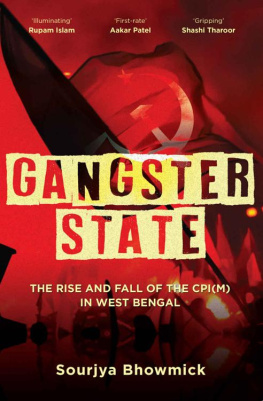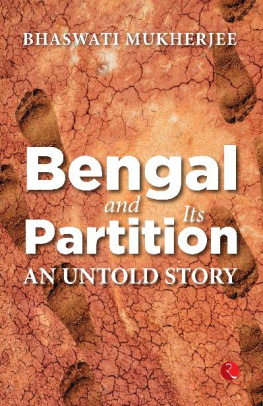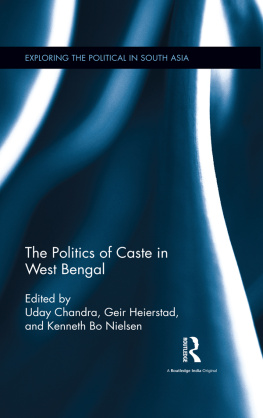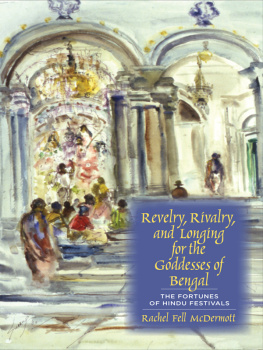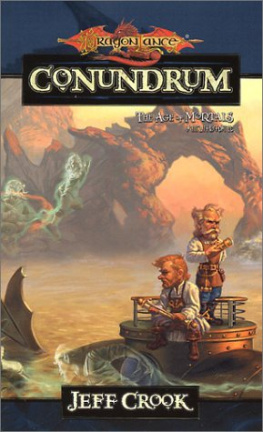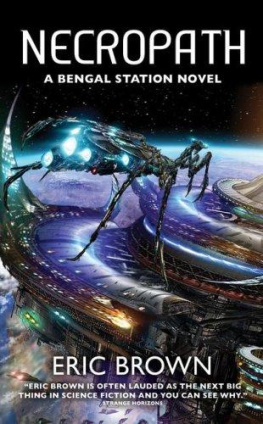THE
BENGAL
CONUNDRUM
THE
BENGAL
THE RISE OF THE BJP AND
CONUNDRUM
THE FUTURE OF THE TMC
SAMBIT PAL
BLOOMSBURY INDIA
Bloomsbury Publishing India Pvt. Ltd
Second Floor, LSC Building No. 4, DDA Complex, Pocket C 6 & 7,
Vasant Kunj, New Delhi, 110070
BLOOMSBURY, BLOOMSBURY INDIA and the Diana logo are trademarks of Bloomsbury Publishing Plc
First published in India 2021
This edition published 2021
Copyright Sambit Pal, 2021
Sambit Pal has asserted his right under the Indian Copyright Act to be identified as the Author of this work
Bloomsbury Academic
An imprint of Bloomsbury Publishing Plc
All rights reserved. No part of this publication may be reproduced or transmitted in any form or by any means, electronic or mechanical, including photocopying, recording or any information storage or retrieval system, without the prior permission in writing from the publishers
This book is solely the responsibility of the author and the publisher has had no role in the creation of the content and does not have responsibility for anything defamatory or libellous or objectionable
Bloomsbury Publishing Plc does not have any control over, or responsibility for, any third-party websites referred to or in this book. All internet addresses given in this book were correct at the time of going to press. The author and publisher regret any inconvenience caused if addresses have changed or sites have ceased to exist, but can accept no responsibility for any such changes
ISBN: PB: 978-93-89714-79-1; eBook: 978-93-89812-68-8
2 4 6 8 10 9 7 5 3 1
Created by Manipal Digital
To find out more about our authors and books visit www.bloomsbury.com and sign up for our newsletters
CONTENTS
Whatever you say, you will see, Didi will come to power!
Mahesh Barman, a lean but able-bodied man, uttered these words with full conviction while looking straight ahead through the windscreen and holding the steering wheel of the car tightly. The words had so much power that the car full of journalists went silent. He was a farmer from North Bengals Cooch Behar who earned a living by driving hired vehicles in and around Kolkata, and his words had silenced all of us, a pack of seasoned journalists. There were reasons for his sharp and sudden reaction.
Almost a decade ago, some of my senior colleagues from other media housesPrasenjit Bakshi, Jayanta Chowdhury, Rabishankar Dutta and Jagannath Chattopadhyayand I routinely met up at the end of the day on our way home. We would dissect Bengal politics and evaluate the political moves by the Left, Right and the Centre. Maheshda was generally not part of our discussions. He was privy to our political critique but never contributed unless asked. The day Maheshda spoke up, we were perhaps critically evaluating a move by the Trinamool Congress (TMC) and Maheshda could not control himself.
In 200809, when Mamata Banerjee was riding high on the popularity bandwagon on the back of the anti-land-acquisition-movement and inching closer to the house of power in the state, Maheshda voiced the popular sentiment of the common man in Bengal.
His outburst made me ponder the sharp distinction between the popular sentiment and the underlying politics behind the creation of such a narrative.
Minutes later, we stopped by our designated road-side tea stall. As my colleagues sipped steaming hot tea from bhanrs (earthen cups) and I gulped my favourite boiled eggs, I seriously thought about the possibility of documenting the politics, and not just the politicking, of Bengal. I proposed to my colleagues that we should write a book on the contemporary political history of Bengal as objectively as possible, drawing from our first-hand experiences. However, the dream remained unfulfilled due to our busy professional lives.
In 2017, as winds of change seemed to be blowing once again in Bengal and the political scenario started metamorphosising, the dream resurfaced. The Left Front government was dislodged in 2011 by the Mamata Banerjeeled TMC and the BJP was gradually emerging as the principal Opposition party. At that time, I was writing a weekly column on Bengal politics, without being prejudiced or partisan, in Bengali for Ebela Digital . Initially, I was almost determined to compile my weekly pieces into a book.
Before the idea materialized and I transformed from a full-time journalist to media educator and freelancer, one fine afternoon in June 2019, another thought struck my mind. Why shouldnt I attempt to reach the national audience? West Bengal had made national headlines in 2019 when Narendra Modi returned to power for the second term. The BJP bagged 18 seats out of 42, decimating the ruling TMC in the state. I felt the national audience must be interested in understanding the reason behind this sudden surge in support for the saffron camp in Bengal. How could the citadel of the Left (remember, Mamata Banerjee was branded as being more Left than the original Left) suddenly change its direction?
I immediately rang Kanishka Gupta, the founder of Writers Side, with a lot of apprehensions, wondering if he would tolerate a stranger and a first-time author from Bengal willing to write on Bengal politics. To my utter surprise, Kanishka turned out to be more excited than me about the book. Thus, the journey began.
After rejections, mentoring, restructuring the proposal and rewriting the draft chapters, finally, the idea landed in the hands of my editor, Bloomsburys Prerna Vohra. Our long discussions on national and Bengal politics and this book boosted my confidence. They helped me find a proper direction and gave the narrative shape. I would like to thank Kanishka, Prerna and Amish Mulmi (who briefly mentored me at an initial stage) for their valuable inputs to make this book happen.
The book does not only aim to examine why the rightist force engulfed the imagination of the people of Bengal, who often boasted of being progressive, Left-liberal flagbearers of communal harmony. It is also not just about showing why Mamata Banerjee fell from grace. This book is an attempt to present a holistic view of Bengal politics over the last couple of years. With reference to the past and present political incidents, I have tried to demonstrate how Mamata Banerjees TMC, despite enjoying popular support and implementing social welfare schemes, gave way to the BJP. I also critically evaluate the role of the Left and the saffron camps politics of polarization. In the end, I outline how Mamata Banerjee has been trying to fight back in the face of the BJPs onslaught post the 2019 Lok Sabha elections.
The broad reasons behind this unprecedented politically pathbreaking result (as I have identified in this book) areMamata Banerjees absolutism and overdependence on the administration rather than the party organization; her political, ideological and organizational weaknesses and her failure to arrest corrupt practices at the grassroots; her alleged minority-appeasement, which gave rise to Hindutva politics; the swing of the Left support base towards rightist forces; and the groundwork done by the RSS for years, the organizational restructuring of the Bengal BJP and the shift in focus of central leadership towards the East. The politics of development has gradually been replaced by identity politics.
The discussions on the above points do not maintain a strict timeline. To me, the agitation and the violence that followed in Darjeeling in the summer of 2017 in the presence of Mamata Banerjee and her full cabinet marked a turning point in recent Bengal politics, which has been dominated by Banerjee since 200708. This was the first direct challenge to her authority since she came to power in 2011. So, the book starts with the Darjeeling incident. I have tried to pick up such political developments, going back and forth, to explain the broad points of the book rather than chronologically narrating and analysing the change of politics in Bengal.


